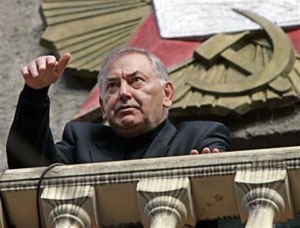
OSSETIA RESISTS RETURN OF INGUSH REFUGEES
Publication: Eurasia Daily Monitor Volume: 2 Issue: 163
By:

One of the many difficult problems in the North Caucasus is the land dispute between North Ossetia and Ingushetia.
Prigorodny district was incorporated into Ossetia after the deportation of the Ingush in 1944. When the Ingush were allowed to return to the Caucasus after Stalin’s death in 1953, some of them settled in this district, but in 1991, when Chechnya and Ingushetia were divided into two republics, Ingush leaders suggested returning Prigorodny to Ingushetia. Their arguments were backed by two federal laws, “Compensation to Peoples Repressed during Stalin’s Time” and “The Formation of the Republic of Ingushetia,” which said that Prigorodny district was part of Ingushetia. The Ossetians refused to accept that ruling and brutally forced all Ingush residents to leave Ossetia for their own republic. Since that time, the Ingush government has continually demanded that the Ossetians allow the Ingush refugees return to Prigorodny district. Usually the Kremlin backed the Ossetian side, but last year the situation began to change.
On June 21, 2004, Chechen and Ingush gunmen attacked military and police facilities in Ingushetia, causing a high casualty toll. Now Moscow understood that if they continued to favor the Ossetian side, they would soon face the strengthening Ingush insurgency. The Kremlin realized there should be some concessions given to the Ingush in order to resolve the conflict as soon as possible. Ingush President Murat Zyazikov sent a clear message to the Kremlin, saying that the stabilization of the situation in Ingushetia depended on the Ingush issue. At the press conference held two weeks after the June 2004 raid, Zyazikov complained, “People should return where they want to return. They used to live there, on the territory of North Ossetia” (Regnum, July 7, 2004).
After the issue languished for almost a year, in March the Ingush deputies in the Russian parliament asked Russian President Vladimir Putin to clarify the borders of Ingushetia. One month later the Ingush MPs also asked Dmitry Kozak, Putin’s envoy to the Southern Federal District, to monitor the issue (polit.ru, April 8). At the same time, the Ingush opposition was gaining popularity by raising the Prigorodny issue.
On April 6, Kozak invited Zyazikov and Ossetian President Alexander Dzasokhov to Rostov-on-Don to sign an agreement that would settle the Ingush refugees in the village of Maiysky, Ossetia, near the Ingush border. In return, the Ingush side would drop their demands.
While the Ingush authorities were ready to sign, the Ossetian president refused, saying that resolution could only come when “the terrorist bases [in the North Caucasus] are destroyed” (Kommersant, April 8).
Putin, enraged by the failure, ordered Kozak to solve the refugee problem by the end of 2006. Then the Russian authorities chose what they believed was the easiest way to solve the problem: money. Igor Yunash, the deputy director of the Russian Migration Service, offered the refugees two alternatives: either get compensation in cash and choose any place to live, or move to the special settlement in Ossetia named “Novy,” which means “new” in Russian (Vremya novostei, July 27).
The Ingush authorities, especially Kazbek Sultigov, chairman of the Ingush government’s Refugee Committee, hated this proposal. During the talks with Kozak and the Ossetians, Sultigov kept insisting that the refugees only wanted to return to their native villages in Ossetia. In fact, this process was already underway as more and more Ingush went to live in Maiysky, Tarskoe, and other villages. Sultigov wanted to have this informal process controlled by the Russian, Ossetian, and Ingush authorities.
The Ossetian government had other plans. Their priority was to get rid of all Ingush, and they considered letting the Ingush live in the Novy reservation, in Ossetia, to be a significant concession. Worried about the Ingush migration, the Ossetian extremists turned to violence. Late in July, a car going from Ingushetia was fired upon in Prigorodny district. On July 15, as Sultigov returned from Ossetia to Ingushetia after the talks with Kozak and the Ossetian government, his car was ambushed near Vladikavkaz, the capital of North Ossetia. Sultigov was wounded but survived. On July 27, Chengiz Chakhiev, an Ingush residing in the village of Dachnoe in Ossetia, was found dead with his throat slashed (Kavkazsky Uzel, July 28).
The Russian authorities still feign ignorance of violence against the Ingush in Ossetia. “The attempt on Sultigov’s life has criminal roots. I warn all hot heads against inspiring ethnic conflict because of this accident,” Kozak cautioned afterward (Kavkazsky Uzel, July 15).
However, the Ossetian-Ingush talks were cancelled after the violent attacks. The Ossetians, who are not interested in a dialogue with the Ingush, succeeded in terrifying the Ingush instead. It is time now for the Kremlin to put pressure on Vladikavkaz, but Moscow resists, as doing so would discredit the Kremlin in the eyes of the Ossetians, a close Russian ally in the Caucasus. The Kremlin’s actions in the republic are already strained by the negative attitude of the locals toward the Russian authorities after the Beslan tragedy one year ago.
Yet, the Ingush, who can rely on support from the rebels in the future, will not retreat from their demands either.




